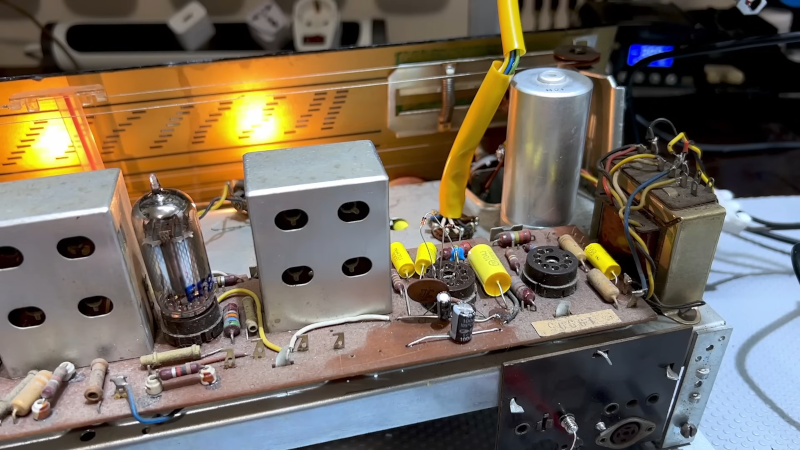[M Caldeira] had a project in mind: replacing a common vacuum tube with a solid-state equivalent. The tube in question was an EABC80 or 6AK8 triple diode triode. The key was identifying a high-voltage FET and building it, along with some other components, into a tube base to make a plug-in replacement for the tube. You can see a video about the project below.
These tubes are often used as a detector and preamplifier. Removing the detector tube from a working radio, of course, kills the audio. Replacing the tube with a single diode restores the operation of the radio, although at a disadvantage.
From there, he adds more diodes directly into the socket. Of course, diodes don’t amplify, so he had to break out a LND150 MOSFET with a limit of 500 volts across the device. It takes some additional components, and the whole thing fits in a tube base ready for the socket.
Usually, we see people go the other way using tubes instead of transistors in, say, a computer. If you want real hacking, why not make your own tubes?















Article in QST from 1969 about replacing existing tube circuits with fets https://www.qsl.net/kh6grt/page4/tubesters/MOSFETs%20for%20Tubes.pdf
That seems to be a still-plentiful ten-dollar tube…
Yes, I suppose you _could_ just go buy a new tube for ten bucks instead of spending much more money and tons of time messing around with high voltage just to create a one-off niche alternative… but… but… why?
Rec’d.
It isn’t. Production stopped half a century ago and they never appeared in regions where FM was introduced after the early 1960s. Expect to pay >25€ for a NOS EABC80 with warranty.
I remember such tubes and euro stuff versus the all american five and passed on them. Extra diodes in a tube for example.
Nice shop but no brush and vacuum to start a restoration. Having to touch all that dust whilst recapping no clean hands. I always blow out with shop air especially pots and switches first or vacuum and a small paintbrush. Get the dust oxides etc. out first before spraying anything in like cramolin. Clean and noise free vs. a little mud to dry out and go bad again.
Before now, I didn’t know high voltage FETs existed.
https://www.microchip.com/en-us/product/LND150
I knew they could go up past 1KV, but in the back of my mind practicality wise, it was more of a matter of how much heat are you willing to dissipate rather than breakdown voltages. I suppose that’s one way you can convince someone it still has a warm tone when you can still make toast on it.
MMMMM! Toast
There’s also an old article from an old 73 Magazine about replacing the tubes in a Heathkit IG-103 signal generator. I had a second, beat-up IG-102 and did just that. It works perfectly.
I re-used the transformer and cord in another project, and replaced the neon lamp with a Red LED.
It runs from a 9V battery!
Teledyne manufactured solid-state tube replacements called Fetrons. There was even an experimental program to replace certain tube types in the AN/FSQ-7 (SAGE) computer at McChord AFB with Fetrons. Here are pictures of one:
http://q7.neurotica.com/Oldtech/SAGE/PC130021.JPG
http://q7.neurotica.com/Oldtech/SAGE/PC130022.JPG
http://q7.neurotica.com/Oldtech/SAGE/PC130023.JPG
The Fetrons could only be used in certain areas of the computer, since marginal testing could not be applied to them.
I have a Heathkit V-7A VTVM with Fetrons in it. Heathkit sold a Fetron upgrade kit for it. The upgraded meter is ready to use as soon as it’s switched on, but the fetrons are not as robust as the original tubes. They tend to die when the meter is used with the optional high voltage probe.
Older tube equipment could really benefit from something like this. Using high performance modern semis in an old tried and true design could result in much higher total performance of the equipment. It would be interesting to see if a depletion mode mosfet exists that could replace the higher current output triodes used in the output stage of a Guitar Amp. Maybe 300W. Would the harmonic distortion be acceptable to more discriminating ears? Could the output power be raised up to 1000W ?